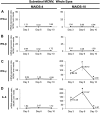Suppressor of Cytokine Signaling 1 (SOCS1) and SOCS3 Are Stimulated within the Eye during Experimental Murine Cytomegalovirus Retinitis in Mice with Retrovirus-Induced Immunosuppression
- PMID: 29976680
- PMCID: PMC6146705
- DOI: 10.1128/JVI.00526-18
Suppressor of Cytokine Signaling 1 (SOCS1) and SOCS3 Are Stimulated within the Eye during Experimental Murine Cytomegalovirus Retinitis in Mice with Retrovirus-Induced Immunosuppression
Abstract
AIDS-related human cytomegalovirus retinitis remains the leading cause of blindness among untreated HIV/AIDS patients worldwide. To study mechanisms of this disease, we used a clinically relevant animal model of murine cytomegalovirus (MCMV) retinitis with retrovirus-induced murine AIDS (MAIDS) that mimics the progression of AIDS in humans. We found in this model that MCMV infection significantly stimulates ocular suppressor of cytokine signaling 1 (SOCS1) and SOCS3, host proteins which hinder immune-related signaling by cytokines, including antiviral type I and type II interferons. The present study demonstrates that in the absence of retinal disease, systemic MCMV infection of mice without MAIDS, but not in mice with MAIDS, leads to mild stimulation of splenic SOCS1 mRNA. In sharp contrast, when MCMV is directly inoculated into the eyes of retinitis-susceptible MAIDS mice, high levels of intraocular SOCS1 and SOCS3 mRNA and protein are produced which are associated with significant intraocular upregulation of gamma interferon (IFN-γ) and interleukin-6 (IL-6) mRNA expression. We also show that infiltrating macrophages, granulocytes, and resident retinal cells are sources of intraocular SOCS1 and SOCS3 protein production during development of MAIDS-related MCMV retinitis, and SOCS1 and SOCS3 mRNA transcripts are detected in retinal areas histologically characteristic of MCMV retinitis. Furthermore, SOCS1 and SOCS3 are found in both MCMV-infected cells and uninfected cells, suggesting that these SOCS proteins are stimulated via a bystander mechanism during MCMV retinitis. Taken together, our findings suggest a role for MCMV-related stimulation of SOCS1 and SOCS3 in the progression of retinal disease during ocular, but not systemic, MCMV infection.IMPORTANCE Cytomegalovirus infection frequently causes blindness in untreated HIV/AIDS patients. This virus manipulates host cells to dysregulate immune functions and drive disease. Here, we use an animal model of this disease to demonstrate that cytomegalovirus infection within eyes during retinitis causes massive upregulation of immunosuppressive host proteins called SOCS. As viral overexpression of SOCS proteins exacerbates infection with other viruses, they may also enhance cytomegalovirus infection. Alternatively, the immunosuppressive effect of SOCS proteins may be protective against immunopathology during cytomegalovirus retinitis, and in such a case SOCS mimetics or overexpression treatment strategies might be used to combat this disease. The results of this work therefore provide crucial basic knowledge that contributes to our understanding of the mechanisms of AIDS-related cytomegalovirus retinitis and, together with future studies, may contribute to the development of novel therapeutic targets that could improve the treatment or management of this sight-threatening disease.
Keywords: AIDS-related cytomegalovirus retinitis; MAIDS; SOCS1; SOCS3; murine cytomegalovirus (MCMV); retinitis; suppressor of cytokine signaling (SOCS).
Copyright © 2018 American Society for Microbiology.
Figures









Similar articles
-
SOCS and Herpesviruses, With Emphasis on Cytomegalovirus Retinitis.Front Immunol. 2019 Apr 11;10:732. doi: 10.3389/fimmu.2019.00732. eCollection 2019. Front Immunol. 2019. PMID: 31031749 Free PMC article. Review.
-
Reduced frequency of murine cytomegalovirus retinitis in C57BL/6 mice correlates with low levels of suppressor of cytokine signaling (SOCS)1 and SOCS3 expression within the eye during corticosteroid-induced immunosuppression.Cytokine. 2017 Sep;97:38-41. doi: 10.1016/j.cyto.2017.05.021. Epub 2017 May 28. Cytokine. 2017. PMID: 28558309 Free PMC article.
-
Murine cytomegalovirus downregulates interleukin-17 in mice with retrovirus-induced immunosuppression that are susceptible to experimental cytomegalovirus retinitis.Cytokine. 2013 Mar;61(3):862-75. doi: 10.1016/j.cyto.2013.01.009. Epub 2013 Feb 14. Cytokine. 2013. PMID: 23415673 Free PMC article.
-
Murine cytomegalovirus infection of mouse macrophages stimulates early expression of suppressor of cytokine signaling (SOCS)1 and SOCS3.PLoS One. 2017 Feb 9;12(2):e0171812. doi: 10.1371/journal.pone.0171812. eCollection 2017. PLoS One. 2017. PMID: 28182772 Free PMC article.
-
Interleukin-2 immunotherapy and AIDS-related cytomegalovirus retinitis.Curr HIV Res. 2004 Oct;2(4):333-42. doi: 10.2174/1570162043351066. Curr HIV Res. 2004. PMID: 15544454 Review.
Cited by
-
Cytomegalovirus Retinitis in HIV and Non-HIV Individuals.Microorganisms. 2019 Dec 28;8(1):55. doi: 10.3390/microorganisms8010055. Microorganisms. 2019. PMID: 31905656 Free PMC article. Review.
-
A Mouse Model That Mimics AIDS-Related Cytomegalovirus Retinitis: Insights into Pathogenesis.Pathogens. 2021 Jul 6;10(7):850. doi: 10.3390/pathogens10070850. Pathogens. 2021. PMID: 34358000 Free PMC article. Review.
-
Transcriptional analysis of immune response genes during pathogenesis of cytomegalovirus retinitis in mice with murine acquired immunodeficiency syndrome.PLoS Pathog. 2020 Nov 6;16(11):e1009032. doi: 10.1371/journal.ppat.1009032. eCollection 2020 Nov. PLoS Pathog. 2020. PMID: 33156834 Free PMC article.
-
SOCS and Herpesviruses, With Emphasis on Cytomegalovirus Retinitis.Front Immunol. 2019 Apr 11;10:732. doi: 10.3389/fimmu.2019.00732. eCollection 2019. Front Immunol. 2019. PMID: 31031749 Free PMC article. Review.
-
The Role of Caspase-12 in Retinal Bystander Cell Death and Innate Immune Responses against MCMV Retinitis.Int J Mol Sci. 2021 Jul 29;22(15):8135. doi: 10.3390/ijms22158135. Int J Mol Sci. 2021. PMID: 34360899 Free PMC article.
References
-
- Mocarski ES Jr, Shenk T, Pass RF. 2007. Cytomegalovirus, p 2702–2772. In Knipe DM, Howley PM (ed), Fields virology, vol 2 Lippincott Williams & Wilkins, Philadelphia, PA.
-
- Mocarski ES Jr, Shenk T, Griffiths PD, Pass RF. 2013. Cytomegaloviruses, p 1960–2014. In Knipe DM, Howley PM, Cohen JI, Griffin DE, Lamb RA, Martin MA, Racaniello VR, Roizman B (ed), Fields virology, 6th ed, vol 2 Lippincott Williams & Wilkins, Philadelphia, PA.
Publication types
MeSH terms
Substances
Grants and funding
LinkOut - more resources
Full Text Sources
Other Literature Sources
Research Materials

